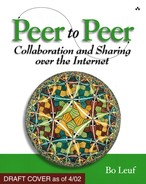Foreword
Like the Web, peer to peer (p2p) networking grew rapidly out of user desire. Whether sharing music, pictures, or conversation, the user urge to connect on a one-to-one basis, without the intervention of a centralized governing authority, seems to express a fundamental human need.
Again like the Web, the initial growth of peer technologies came from mainly non-commercial motivations. Indeed, in for instance the case of Napster, it came from downright anti-commercial motivations! Now, p2p comes to the range of its adoption curve where many of the most egregious excesses of file swapping are being tamed, and the business community is trying to figure out how to take advantage of the tremendous natural energy that’s apparent in the millions of swappers, chatters and hosters in p2p communities.
The trouble is, unlike the Web, p2p networking is not a single, simple communication protocol. It’s not even a single networking structure. Most peer implementations don’t particularly concern themselves with any clearly defined content types, nor is the technology normally targeted for specific business or personal purposes. The p2p model crops up in a variety of applications: file sharing, instant messaging, and resource allocation, to name a few. In all these cases, we see a similarity of application, but there are many differences in specific implementation.
Bo Leuf’s book, Peer to Peer: Collaboration and Sharing over the Internet, comes along at a very good time for those of us actively looking to adapt our current business practices to the peer-to-peer model, or looking to develop next generation peer tools.
The book is interesting, well organized, informatively illustrated, and engagingly written. It especially well balances technical, functional, business, and legal information, and presents the material in a way that is useful for both the executive and technical reader—no mean feat.
Although his initial deconstruction of the p2p hype might tempt you momentarily to conclude, in the words of Gertrude Stein, that “there is no there there”, this drastic approach allows for a more meaningful definition of what p2p is, based on first principles. As we are shown in the process, peer to peer is both less and more than you may have been led to believe. It is less, in that there is no short and simple defined protocol and tool suite for you to jump in and use. It is more, in that the shape of peer-to-peer relationships is rapidly becoming a new and fundamental means for users and machines to communicate. This relationship can be powerfully transformative, as the music industry has already discovered.
Mitchel Ahern
Director, Business Development
AdTools Inc., A SonyMusic Company
